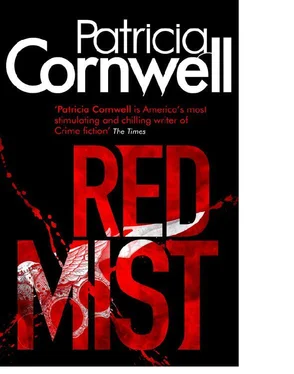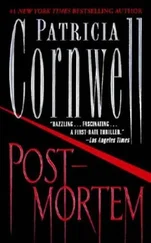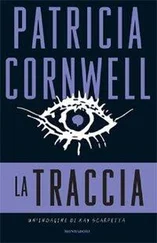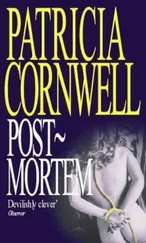“In summary, I was to be here in Savannah very briefly for another reason and was informed last night that an appointment was made for me to come to your office. I gather you aren’t being cooperative in a way that suits her,” I say to him. “I told her you’re slightly stubborn and not a redneck.”
“Well, I am a redneck,” he says. “But I think I’m understanding why you didn’t call me yourself, and that makes me feel better, because I did feel a little dissed. Maybe that’s stupid, but I did, it was so out of the blue hearing from her and not you. Regardless of anything personal, I think I get what’s going on more than you might imagine. Jaime Berger is somewhat histrionic, and it fits her script if I’m the redneck bigoted medical examiner in Savannah who stone-walls her because I’m intent on Lola Daggette getting the needle. You know, kill ’em all and let God sort ’em out. That’s the way everybody thinks south of the Mason-Dixon Line. And west of it.”
“Jaime says you didn’t come out to greet her when she was here. That you ignored her.”
“I sure as hell didn’t greet her, because I was talking on the phone to a poor woman who didn’t want to be told that her husband’s death was a suicide.” His eyes narrow, and he gets louder and more indignant. “That his gun didn’t accidentally go off while he was outside drinking beer and mending his crab pots. And just because he hugged her and seemed to be in an unusually good mood and said he loved her before he went outside that night didn’t mean he didn’t have suicidal thoughts, and I deeply regretted that what I filled in on the autopsy report and his death certificate means she won’t get his life insurance. I’m right in the middle of having to tell someone shit like that when Berger shows up here dressed like Wall Street. Then she’s hovering in my damn doorway while the woman is crying uncontrollably on the other end and I sure as hell wasn’t going to hang up on her and offer some pushy New York attorney coffee.”
“I can see you have no feelings about her,” I say wryly.
“I’ve got the Jordan cases for you, including photographs of the crime scene, which I think you’ll find helpful. I’ll let you look and get your own impressions, and then I’m happy to discuss anything you want.”
“There’s a perception you are convinced that Lola Daggette committed the murders and did so alone. As I recall from your presentation of this case during the NAME meeting in Los Angeles, you seem pretty firm in your opinion.”
“I’m on the side of truth, Kay. Just like you.”
“I must admit I find it unusual that DNA supposedly from blood and skin under Brenda Jordan’s fingernails wasn’t a match for Lola Daggette. And it didn’t match a family member. An unknown DNA profile, in other words.”
“ Supposedly being the operative word.”
“I might conclude from the DNA that it’s possible more than one assailant or intruder was involved,” I add.
“I don’t interpret the lab reports or decide what they mean.”
“I’m just curious if you have an opinion about it, Colin.”
“Brenda Jordan’s hands were incredibly bloody,” he says. “Yes, an unknown DNA profile was related to my swabbing under her nails when I did the autopsies, but I don’t know what that means. It could have been from an unrelated source. Her own blood was under her nails. Her brother’s DNA was under her nails.”
“Her brother’s?”
“He was in the bed next to hers, and I’m guessing his blood was transferred to Brenda’s body, to her hands, when the killer attacked her, probably after murdering Josh first. Or maybe the killer stabbed Brenda first. Maybe the killer thought she was dead and started on the brother, and Brenda wasn’t dead and tried to run. I don’t know exactly what happened and probably never will. Like I said, I don’t interpret lab reports or decide what they mean.”
“I feel compelled to emphasize that an unknown donor of DNA at that scene should have caused the police to consider more than one assailant might have been involved.”
“In the first place, the scene wasn’t contained all that well, and a lot of people ended up in the house who shouldn’t have been there.”
“And these people who shouldn’t have been there touched the bodies?”
“Well, not that, thank God. The cops know better than to let anyone near my bodies or they’ll have hell to pay from me. But more to the point, at the time it just wasn’t accepted as a possibility that someone other than Lola Daggette was involved.”
“Why?”
“She was in a halfway house to deal with anger management and her problems with drugs. Within hours after the murders, she was discovered washing clothing that was stained with the Jordans’ blood. And she was local. I remember there was some talk at the time that she might have read or heard about Dr. Jordan in the news and realized he had a lot of money, was a successful doctor from an old Savannah family that had made a fortune from cotton. His mansion was an easy walk from the halfway house, where she’d been for more than a month when the murders occurred. She’d had plenty of time to gather intelligence, including figuring out that the family didn’t always bother with the alarm system.”
“Because they’d had a number of false alarms.”
“Kids,” he says. “A big problem with alarm systems is kids accidentally setting them off.”
“What seems to be nothing more than conjecture,” I point out. “It’s also conjectured that burglary wasn’t the motive.”
“No evidence of it, but who knows? An entire family dead. If something was missing, who’s going to say?”
“Was the house ransacked?”
“It wasn’t. But again, if everyone is dead, who’s to say if something was looked through or moved?”
“So the DNA results didn’t concern you at the time. I don’t mean to keep pushing you on this. But the results bother me.”
“Push all you want. Just doing my job. I’ve got no dog in the fight,” he says. “The DNA was commingled. As you well know, it’s not always simple to decide what sample the result is from. Was the unknown DNA from blood or skin cells or from something else, and when was it left? It could have been from a source that has nothing to do with the case. A recent guest in the house. Someone Brenda had been in contact with earlier in the day. You know what they say. Don’t put your case in a lab-coat pocket. DNA doesn’t mean crap if you don’t know how it got there and when. In fact, it’s my theory that the more sensitive the testing gets, the less it’s going to mean. Just because someone breathed in a room doesn’t mean that person killed anyone. Well, don’t get me started. You didn’t come all this way to hear my philosophizing and sounding like a Luddite.”
“But no DNA profile at the crime scene or associated with the bodies was Lola Daggette’s.”
“That’s right. And it’s not up to me to decide who’s guilty and who’s not, or even to care. I just report my findings, and the rest is up to the judge and jury,” he says. “Why don’t you take a look at what I’ve left for you, and then we’ll chat.”
“I understand Jaime discussed Barrie Lou Rivers with you, too. I’m wondering if I might take a look at her case while I’m at it.”
“Jaime Berger’s got copies. She put in her requests for records, I don’t know, at least two months ago.”
“If it’s not too much trouble, I always prefer originals when I can get them.”
“That record’s not paper because it’s more recent. You know, GBI’s gone all paperless. I can have it printed, or you can look on a computer.”
“Electronic is fine. Whatever’s easiest.”
Читать дальше












